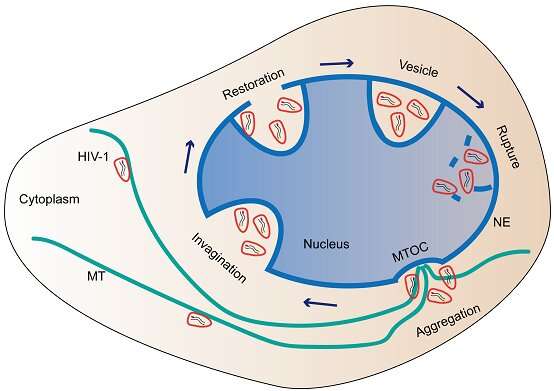HIV-1 viral cores enter nucleus collectively through nuclear endocytosis-like pathway

In a study published online in Science China Life Sciences on May 15, ZHANG Xian-En's team from Institute of Biophysics of the Chinese Academy of Sciences and collaborators discovered how HIV-1 viral cores can enter the nucleus. The researchers made their observations by combining cellular molecular imaging and electron microscopy.
It is widely acknowledged that the process of HIV-1 infecting cells involves the following steps: membrane fusion, viral core release, reverse transcription, capsid disassembly in the cytoplasm, nuclear entry of the viral genome, and viral genome integration, followed by reproducing themselves using the host cell system. However, recent studies have found that viral capsids also exist in the nucleus, and play roles of integration site selection and immune escape.
The new report shows that the HIV-1 viral capsid becomes uncoated near the site of chromosome integration. Considering that the size of HIV-1 viral core is much larger than the nuclear pores, how the viral cores pass through the nuclear membrane barrier remains unknown.
In this study, the researchers differentially labeled the selected components of HIV-1 and the host cells so that the virus-host cell interaction could be dynamically tracked.
They found that after entering the cell, the viral particles moved along the microtubules and selectively gathered at the microtubule organization center (MTOC), leading the nearby nuclear envelope (NE) to undergo deformation, invagination and restoration to form a nuclear vesicle in which the viral cores were wrapped. Then the inner membrane of the nuclear vesicle ruptured to release HIV-1 into the nucleus.
This phenomenon is similar to cell endocytosis and therefore named "nuclear endocytosis-like pathway." Factors involving in the process were preliminarily investigated.
This study expands the understanding of the complexity of HIV-1 nuclear entry, which may provide new insights to HIV-1 virology. The molecular details and viral biology of the mechanism need further elucidation.
More information: Xia Li et al. HIV-1 viral cores enter the nucleus collectively through the nuclear endocytosis-like pathway, SCIENCE CHINA Life Sciences, DOI: 10.1007/s11427-020-1716-x.
Journal information: Science China Life Sciences
Provided by Chinese Academy of Sciences





















